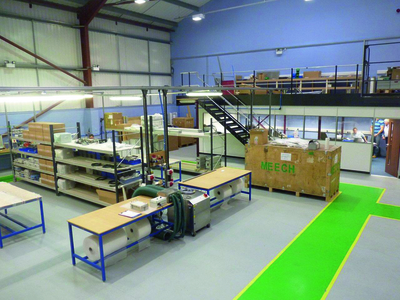Meech has moved its entire web cleaning production to a new building as part of an expansion of its Oxfordshire HQ
Static can cause many quality and productivity issues in the printing process if it is not managed correctly and eliminated. David Rogers, business unit director for static control at Meech International, discusses why the labelling industry really needs to be aware of this issue.
Fundamentally, static is a phenomenon that the labelling industry needs to take notice of because when it is present on a labelling line static attracts dirt and dust, which can result in poor print quality, and necessitates frequent cleaning of the press. With build up, it can also potentially generate harmful operator shocks. This is particularly apparent with today’s more common filmic materials, as they tend to generate higher static charges. End users are demanding more sophisticated standards in the goods they purchase than they may have done a number of years ago, and these filmic materials are being used more commonly as they are pleasing on the eye.
Static can cause a lot of quality and productivity issues in the printing process. Think about a digital label printing line. Here, a massive static charge can be generated both during printing and as the film or paper is unwound from a roll. These charges are capable of attracting dust to the web from several feet away.
Once the dust has deposited on the material, it can cause defects in print quality. It is no good if a labelling company offers a fast service but has to keep stopping its machines to clean them because of the build-up of contamination attracted by static charges, or if at the inspection stage labels are rejected, which is of course not only wasteful but costly. This matters even more if the end use for the label is for the pharmaceutical industry or a clean environment.
Problems
Uncontrolled static causes a variety of problems, such as issues with ink adhesion in the printing process, as it can actually repel the ink from the material surface. Not only does this scenario lead to increased production costs, it can also lead to reduced production speeds. Static can also cause problems with feeding of the labels, and in unwinding from the reel, operator shocks are more likely.
Then there is the scenario where other operations further down the line are affected, such as die-cutting, or punching, as high static charges cause materials to cling together.
 David Rogers from Meech International is an expert on static control in the printing process
David Rogers from Meech International is an expert on static control in the printing process
From here stacking and sorting of labels can become problematic as they will not stack neatly, or in the format required. The knock-on effect of this can be that during the final labelling process, labels misfeed, are not applied correctly to the product, or worse, cause line stoppages.
As a whole, the industry is still coming to terms with the effects static can have. A lot of companies are aware (more so today than they might have been five years ago) that particularly in filmic applications static control is needed, but they may not really understand why. That is where the experts can step in and help, with solid knowledge of the different applications and products available to help neutralise the charges, and keep labelling lines running smoothly and at optimum speeds.
New challenges
Printing companies are now expected to offer a full service, from printing, to converting, punching and die-cutting.
In order to successfully fulfil this role, they are having to learn some new tricks when it comes to the more ‘modern’ label. For example, the printing of in-mould labels is a burgeoning market that demands high quality. At each stage static control will be required to ensure correct behaviour of the material.
Labelling is moving in the direction of using filmic linerless products, which are far more environmentally friendly, with less material costs.
However, by their very nature, they will generate far higher static charges than the average label produced today. Combine this with the labelling printers running at faster speeds, not to mention the increasing use of digital print, and there is no doubt that the industry requires up to date static control solutions, backed up by experience of the industry.






